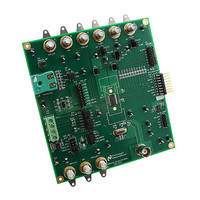LMP90100EB/NOPB National Semiconductor, LMP90100EB/NOPB Datasheet - Page 5

LMP90100EB/NOPB
Manufacturer Part Number
LMP90100EB/NOPB
Description
EVAL BOARD FOR LMP90100
Manufacturer
National Semiconductor
Datasheet
1.LMP90100EBNOPB.pdf
(30 pages)
Specifications of LMP90100EB/NOPB
Main Purpose
Interface, Analog Front End (AFE)
Embedded
No
Utilized Ic / Part
LMP90100
Primary Attributes
8 Programmable Output Data Rates Per Channel
Secondary Attributes
SPI Interface
Silicon Manufacturer
National
Silicon Core Number
LMP90100
Kit Application Type
Data Converter
Application Sub Type
ADC
Kit Contents
LMP90100 Evaluation Board
Lead Free Status / RoHS Status
Lead free / RoHS Compliant
© 2009 National Semiconductor Corporation
E. Configuring the Device Using the Sensor AFE Software
5.
6.
1.
Connect SPIO-4 Board to a PC via USB.
Use a multimeter to measure LMP90100EB’s JP6, JP7; they should all be approximately 5V. If they are
not, check your power supplies and jumpers. Measure JP14.P2; it should be approximately 4.1V. If
it’s not, check your jumpers and U4.
Follow the step-by-step instructions under the “HelpBar” mini-tab (left hand side of the GUI) to
configure the device. The recommended configuration is shown in Figure 4.
a.
b.
c.
d.
e.
f.
g.
h.
i.
Step 1: Select a Sensor - select “DC” “DC” since the input source is not a sensor.
Step 2: Configure Inputs – click on the “INPUT MUX” block to set “VINP = 000: VIN0” and
“VINN = 001: VIN1”. Since VIN0 = (3/4) VREF1 and VIN1 = (1/4) VREF1, the measurement
across this channel will be (1/2) VREF1.
Step 3: Select Reference – click on the “VREF MUX” block to choose “VREF_SEL = 0: VREF1”.
Make sure the VREF1 value is 4.1V.
Step 4: Source IB1/IB2? – this step can be ignored because neither IB1 nor IB2 is connected to the
inputs.
Step 5: Set Gain – since VIN = (1/2) VREF1, the maximum gain that can be set is 2. Click on the
“FGA” block, “PGA” block, or the “Gain” slider to select the gain.
Step 6: Set Buffer – click on the “BUFF” block to include or exclude the buffer from the signal path.
Step 7: Set Calibration - click on the “No Calibration” block to enable or disable calibration. Refer
to the LMP90100 datasheet to more information on the LMP90100’s background calibration types
and modes.
Step 8: Int/Ext CLK? – click on the “CLK MUX” block and make sure the internal clock is selected.
Step 9: Performance - click on the “Performance” mini-tab. This tab displays the Estimated
Device Performance base on the block diagram that you’ve configured, as well as the Measured
System Performance if you’ve connected a board and ran the LMP90100.
Page 5 of 30
with Sensor AFE Software User’s Guide
lmp90100eb_usersguide_20101227_v23.doc
LMP90100 Evaluation Board










